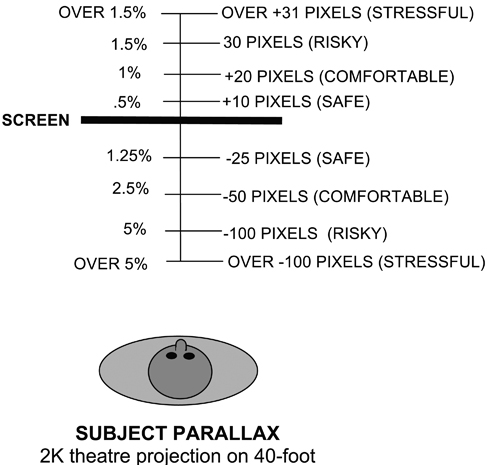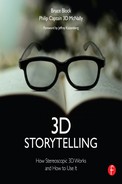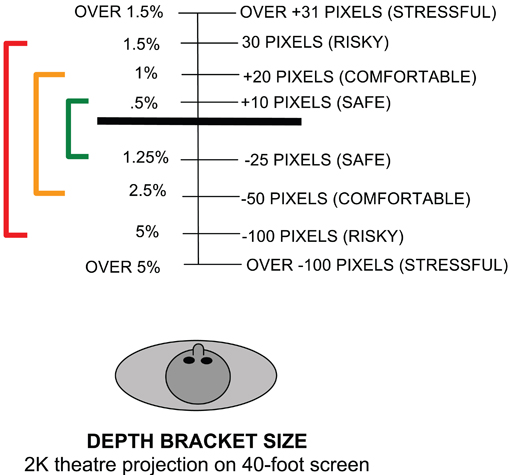Appendix B
Subject Placement and Depth Bracket
The numbers in the following charts are offered as a general guide to placing the subject of the shot in depth.

This chart does not refer to the Depth Bracket. The pixel numbers refer to the subject’s parallax and its position within the Depth Bracket.
This diagram indicates the values for the subject’s parallax on a 40-foot theatre screen. There is a wider range of comfortable viewing in front of the screen than behind it. In front of the screen, a subject’s negative parallax up to −25 pixels will be safe and easy to watch; up to a −50 pixel parallax will be comfortable for most viewers; a subject parallax up to −100 pixels will become increasingly more difficult to watch and over −100 pixels will be visually stressful and should be used only for quick visual punctuations.
Behind the screen, in positive parallax, the subject parallax range is smaller. Subject parallax of +10 pixels is very safe and up to +20 pixels is very comfortable for most viewers; subject parallax between +21 to +30 pixels affects visual comfort and a pixel parallax greater than +30 creates hyper-divergence causing eyestrain.
This diagram can be used as a general rule for the size of the Depth Bracket. Obviously, as the size of the Depth Bracket increases, the amount of depth in the scene increases. The three Depth Bracket examples in the diagram are general examples. The Depth Bracket most appropriate for your production depends on your story and visual style. All of the Depth Bracket examples are taken from successful, modern, digital 3D productions.
A Depth Bracket of about 35 pixels or approximately 1.75 percent (from +10 to –25 indicated with the green bracket) will always create safe, universally acceptable 3D. A Depth Bracket of 70 pixels or about 3.5 percent (from +20 to –50 shown with an orange bracket) will be visually comfortable for most viewers. The largest Depth Bracket is 130 pixels or about 6.5 percent (+30 to −100 in red), which will give the audience the greatest depth range but also create dangerous visual fatigue.
This chart is a guide for subject placement. These measurements assume a HD 2K television that is 60 inches (measured diagonally) with actual screen dimensions of 52 inches wide and 29 inches high.
When considering the Depth Bracket size for TV and what is stressful or safe, remember that different broadcasters may dictate the allowable 3D limits regardless of what is artistically acceptable. Television parallax limits set by the broadcaster are often conservative because there’s a fear of creating visual fatigue, which drives away viewers and reduces advertising revenue. Filmmakers may have to alter their 3D settings to accommodate a variety of broadcast standards.
Depth Bracket Size and Subject vs. Non-Subject
Backgrounds or secondary objects are less sensitive to large parallax settings because, by design, the audience won’t look at them with the same attention they give to the subject. Distant mountains, the sky, or peripheral foreground objects won’t cause eyestrain because the audience is watching the subject instead.
Time is a critical factor in gauging any 3D visual fatigue. A risky or stressful parallax setting will get worse the longer it stays on the screen. Again, if peripheral objects have a stressful parallax setting they can probably remain on screen longer because the audience isn’t looking directly at them.
In 2D and 3D productions, objects that are people, brighter in tone, in-focus, contrasty, moving, or have specific sounds are more likely to attract the audience’s point-of-attention. The audience will tend to ignore objects that are unfamiliar, dark, blurry, lack contrast, stationary, or silent. A Depth Bracket can get surprisingly large and push unimportant objects into the extreme foreground and background without creating visual problems. The audience’s point-of-attention should remain on the subjects within the visually comfortable area of the Depth Bracket. The more extreme parallax of peripheral non-subjects will usually be ignored so an oversized Depth Bracket won’t be a problem. However, peripheral objects with over-exaggerated parallax settings may be so odd-looking that they steal the audience’s attention from the subject. Experience and tests are the best way to see how the Depth Bracket can be extended without causing eyestrain.


